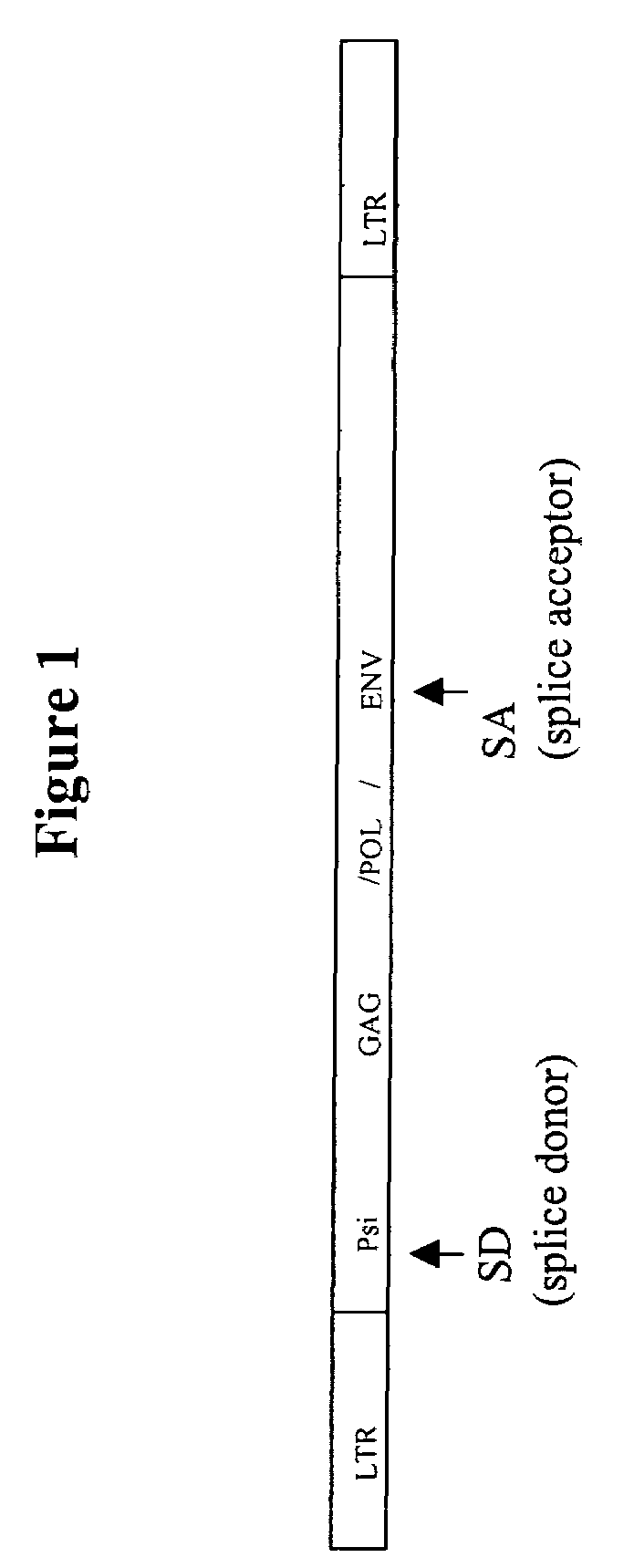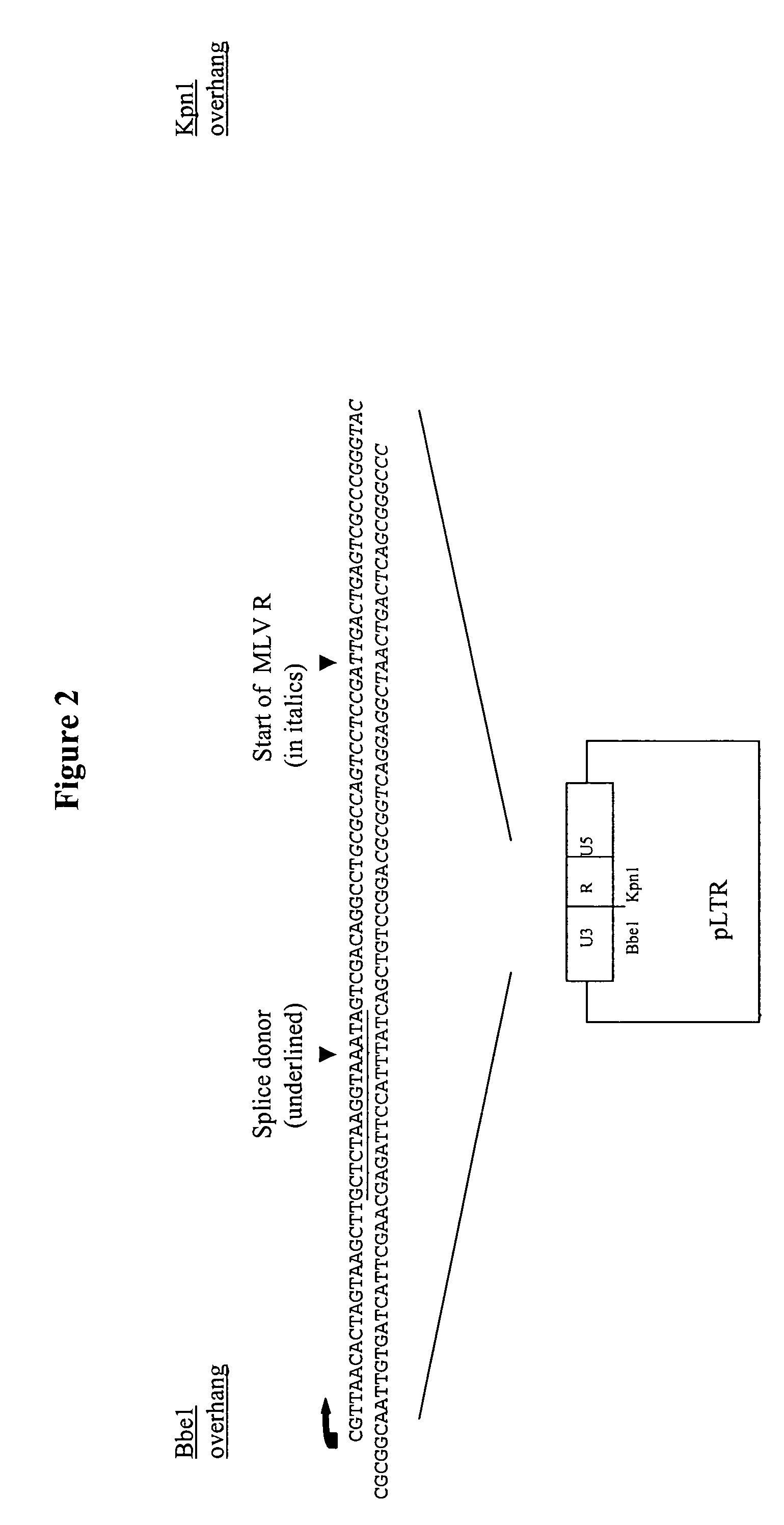Retroviral vectors comprising a functional splice donor site and a functional splice acceptor site
a technology of retroviral particles and acceptor sites, which is applied in the field of vectors, can solve the problems of reducing the potential for production of replication-competent viruses, unable to bring about encapsidation, and defective replication of retroviral vectors
- Summary
- Abstract
- Description
- Claims
- Application Information
AI Technical Summary
Benefits of technology
Problems solved by technology
Method used
Image
Examples
example 1
Construction of a Split-intron MLV Vector
(i) Addition of Small-T Splice Donor:
[0320]The starting plasmid for this construct is pLXSN (Miller el al 1989 ibid); Firstly this construct is digested with Nhe1 and the backbone re-ligated to create an LTR (U3-R-U5) plasmid. Into this plasmid is then inserted an oligonucleotide containing the splice donor sequence between the Kpn1-Bbe1 sites. Also contained within this oligonucleotide, downstream of the splice donor is the MLV R sequence up to the Kpn1. The resulting plasmid is named 3′LTR-SD (see FIG. 2).
(ii) Addition of Splice Acceptor:
[0321]The splice acceptor sequence used in this construct (including the branch point—an A residue between 20 and 40 bases upstream of the splice acceptor involved in intron lariat formation (Aebi et al 1987 Trends in Genetics 3: 102-107) is derived from an immunoglobulin heavy chain variable region mRNA (Bothwell et al 1981 Cell 24: 625-637) but with a consensus / optimised acceptor site. Such a sequence sig...
example 2
Construction of a Split-intron Lentivector
Construction of Initial EIAV Lentiviral Expression Vector (Also see Patent Application GB 9727135.7)
[0324]For the construction of a split-function lentiviral vector the starting point is the vector named pEGASUS-1 (see patent application GB 9727135.7). This vector is derived from infectious proviral EIAV clone pSPEIAV19 (accession number: U01866; Payne et al 1994). Its construction is outlined as follows: First; the EIAV LTR, amplified by PCR, is cloned into pBluescript II KS+ (Stratagene). The MluI / MluI (216 / 8124) fragment of pSEIAV19 is then inserted to generate a wild-type proviral clone (pONY2) in pBluescript II KS+ (FIG. 1). The env region is then deleted by removal of the Hind III / Hind III fragment to generate pONY2-H. In addition, a BglII / NcoI fragment within pol (1901 / 4949) is deleted and a β-galactosidase gene driven by the HCMV IE enhancer / promoter inserted in its place. This is designated pONY2.10nlsLacZ. To reduce EIAV sequence t...
example 3
Construction of an MMLV Amphotropic env Gene with Minimal Homology to the pol Gene and a gag-pol Transcription Cassette
[0349]In the Moloney murine leukaemia virus (MMLV), the first approximately 60 bps of the env coding sequence overlap with sequences at the 3′ end of the pol gene. The region of homology between these two genes was removed to prevent the possibility of recombination between them in cells expressing both genes.
[0350]The DNA sequence of the first 60 bps of the coding sequence of env was changed while retaining the amino acid sequence of the encoded protein as follows. A synthetic oligonucleotide was constructed to alter the codon usage of the 5′-end of env (See FIG. 15) and inserted into the remainder of env as follows.
[0351]The starting plasmid for re-construction of the 5′ end of the 4070A gene was the pCI plasmid (Promega) into which had previously been cloned the Xba1-Xba1 fragment containing the 4070A gene from pHIT456 (Soneoka et al 1995 ibid) to form pCI-4070A....
PUM
 Login to View More
Login to View More Abstract
Description
Claims
Application Information
 Login to View More
Login to View More - R&D
- Intellectual Property
- Life Sciences
- Materials
- Tech Scout
- Unparalleled Data Quality
- Higher Quality Content
- 60% Fewer Hallucinations
Browse by: Latest US Patents, China's latest patents, Technical Efficacy Thesaurus, Application Domain, Technology Topic, Popular Technical Reports.
© 2025 PatSnap. All rights reserved.Legal|Privacy policy|Modern Slavery Act Transparency Statement|Sitemap|About US| Contact US: help@patsnap.com



